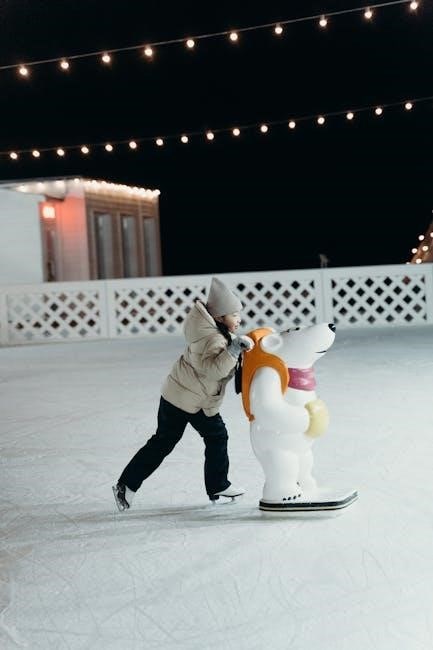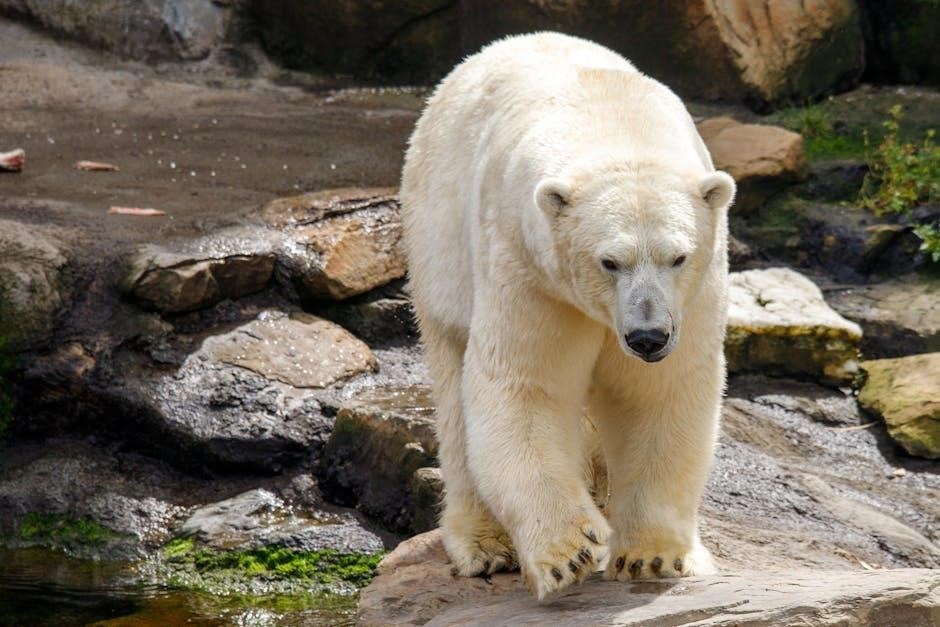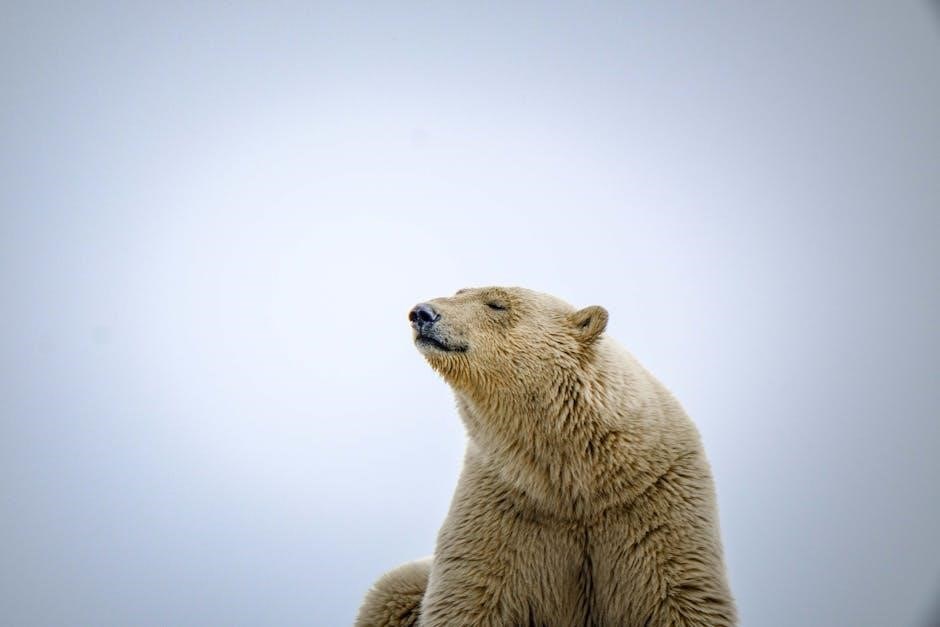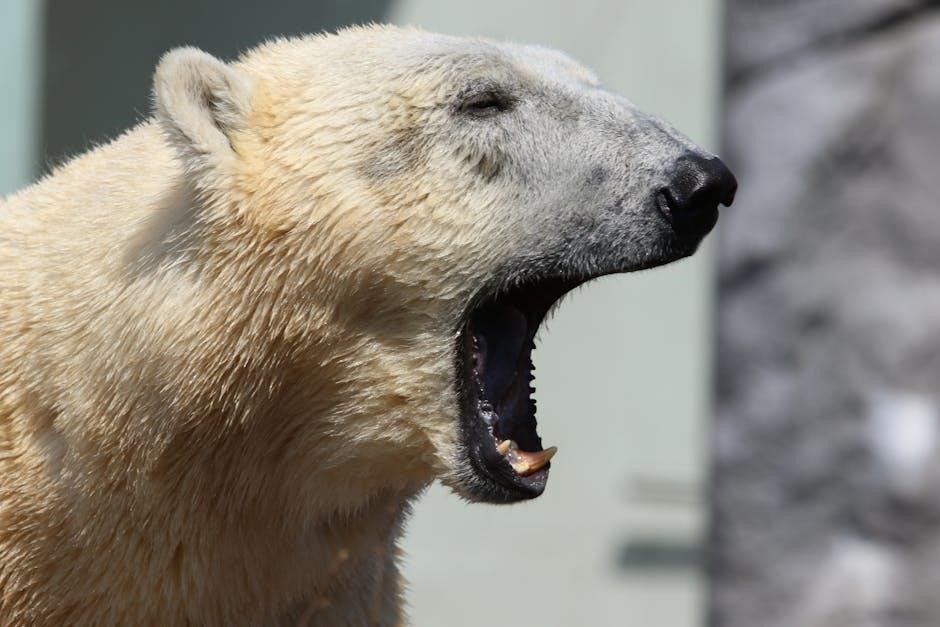The book Polar Bear, Polar Bear, What Do You Hear? is an engaging rhythmic story that encourages children to chant and participate by making animal sounds, fostering interactive learning and creativity through its repetitive and predictable structure.
Background of the Book
Polar Bear, Polar Bear, What Do You Hear? is a captivating children’s book created by the renowned author Bill Martin Jr. and illustrator Eric Carle. First published in 2004, it marks their first collaboration since the beloved classic Brown Bear, Brown Bear, What Do You See?. The story follows a rhythmic and repetitive pattern, beginning with a simple question that builds into a delightful journey through a zoo. The book is a Redbook Children’s Picture Book Award winner, reflecting its enduring popularity. Its engaging structure and vibrant illustrations make it a favorite among children and educators alike, fostering a love for reading and interactive learning. The book’s success lies in its ability to blend education with entertainment seamlessly.
Rhythmic Journey and Engagement
Polar Bear, Polar Bear, What Do You Hear? offers a rhythmic journey that captivates young readers with its repetitive and predictable structure. The book’s engaging format, featuring phrases like “Polar bear, polar bear, what do you hear?”, encourages children to chant along and predict what comes next. This rhythmic pattern, combined with the opportunity to mimic animal sounds, creates an interactive and immersive experience. The story’s flow is designed to foster participation, making it a delightful read-aloud experience for both children and parents. The collaboration between Bill Martin Jr.’s rhythmic text and Eric Carle’s vibrant illustrations ensures that the book is both educational and entertaining, promoting active engagement and a love for storytelling.

Authors Behind the Book
Bill Martin Jr. and Eric Carle, renowned for their contributions to children’s literature, collaborated on Polar Bear, Polar Bear, What Do You Hear?, following their classic Brown Bear.
Bill Martin Jr.: His Contribution

Bill Martin Jr. brought his exceptional storytelling skills to Polar Bear, Polar Bear, What Do You Hear?, creating a rhythmic journey that captivates young readers. His use of repetitive phrases and a question-answer format makes the story predictable and engaging, encouraging children to chant along. Martin’s ability to craft simple yet profound text has made the book a beloved classic, fostering a love for reading and learning in preschoolers. His collaboration with Eric Carle seamlessly blends education with entertainment, ensuring the book’s enduring popularity and educational value.
Eric Carle: His Illustrative Style
Eric Carle’s vibrant and distinctive illustrations in Polar Bear, Polar Bear, What Do You Hear? bring the story to life with his signature collage technique. Using hand-painted tissue papers, Carle creates colorful, textured images that captivate young readers. His artwork is both playful and educational, perfectly complementing the rhythmic text. The visual depictions of zoo animals, from polar bears to peacocks, are both recognizable and imaginative, fostering a sense of wonder. Carle’s style has become iconic in children’s literature, making the book a visual and auditory delight. His collaboration with Bill Martin Jr. ensures a harmonious blend of art and storytelling, leaving a lasting impression on children and parents alike.
Collaboration and Legacy
The collaboration between Bill Martin Jr. and Eric Carle in Polar Bear, Polar Bear, What Do You Hear? marked a triumphant return to their partnership, following the success of Brown Bear, Brown Bear, What Do You See?. This book solidified their legacy as pioneers in children’s literature, blending rhythmic storytelling with vibrant illustrations. The duo’s work has become a cornerstone of early childhood education, celebrated for its ability to engage young minds. Their collaboration not only created a beloved classic but also inspired future generations of authors and illustrators. The book’s enduring popularity is a testament to the timeless appeal of their creative synergy, making it a cherished part of many children’s literary experiences.
Structure of the Book
The book features a rhythmic and repetitive structure, with a question-and-answer format that engages young readers. Its predictable pattern encourages participation and interaction, making it accessible and enjoyable for children.

Repetitive Phrases and Predictability
The book’s structure relies heavily on repetitive phrases, such as “Polar bear, polar bear, what do you hear?” This repetition creates a predictable rhythm, making it easy for young readers to follow and anticipate what comes next. The consistent question-and-answer format encourages children to participate by chanting along, fostering a sense of familiarity and engagement. This predictability not only aids in language development but also helps children feel confident as they join in the storytelling process. The repetitive pattern is a key element that makes the book interactive and memorable, allowing children to connect with the story on a deeper level while developing their early literacy skills.
Animal Sounds and Interactive Elements
The book is rich with animal sounds, inviting children to actively participate by imitating the noises of zoo animals like lions, elephants, and peacocks. These interactive elements create a lively and immersive experience, encouraging children to engage with the story on a auditory and imaginative level. The repetitive structure seamlessly integrates these sounds, making it easy for young readers to join in and predict the next animal’s noise. This interactivity not only enhances the storytelling but also helps children develop phonological awareness and creativity. The animal sounds and prompts to “hear” and “make noise” transform the reading into a dynamic, shared experience, fostering both language skills and imaginative play.
Educational Value
Polar Bear, Polar Bear, What Do You Hear? enhances language skills, phonological awareness, and creativity through its rhythmic patterns and interactive elements, making learning engaging and fun for children.
Language Skills Development
Polar Bear, Polar Bear, What Do You Hear? is a powerful tool for developing language skills in young children. The book’s rhythmic and repetitive structure introduces phonological awareness, helping children recognize and mimic sounds. The predictable phrases encourage participation, allowing kids to chant along and build confidence in their verbal abilities. The story’s simple yet engaging dialogue enhances vocabulary and comprehension. By repeating animal sounds and phrases, children practice pronunciation and develop an ear for rhythm and rhyme. This interactive approach fosters a love for language and lays a strong foundation for future reading and communication skills. The collaboration between Bill Martin Jr. and Eric Carle ensures a balance of educational value and entertaining storytelling.

Creativity and Imagination
Polar Bear, Polar Bear, What Do You Hear? sparks creativity and imagination in children through its engaging and interactive format. The rhythmic text and animal sounds encourage kids to role-play and envision themselves as the zoo animals featured in the story. The book’s repetitive structure allows children to predict and participate, fostering a sense of creative expression. By imitating the sounds and movements of the animals, young readers develop their imaginative skills and explore new ways of storytelling. The vibrant illustrations by Eric Carle further enhance the visual storytelling, inspiring children to think creatively about the world around them. This book is a timeless tool for nurturing imaginative thinking in early childhood development.
Cultural and Zoological Exposure
Polar Bear, Polar Bear, What Do You Hear? introduces children to a variety of zoo animals, fostering an early appreciation for wildlife and diverse species. The book’s zoological elements, such as animal sounds and descriptions, help kids learn about different creatures and their unique traits. Culturally, the story encourages shared reading experiences, promoting bonding and language development. By exploring the sounds and characteristics of animals like polar bears, lions, and zebras, children gain a broader understanding of the natural world. This exposure sparks curiosity and lays the foundation for future learning about ecosystems and conservation, making it a valuable tool for early environmental and cultural education.
Interactive Elements
The book’s rhythmic phrases and repetitive structure encourage children to chant along, while the animal sounds and role-playing elements foster active participation and imaginative engagement with the story.
Chanting and Participation

The book’s rhythmic structure invites children to chant along, creating a shared and immersive reading experience. The repetitive phrases, such as “Polar bear, polar bear, what do you hear?” encourage young readers to predict and join in, fostering a sense of community and engagement. This participatory element not only enhances memory and language skills but also makes the story more enjoyable and interactive. Parents and educators often report that children eagerly anticipate and repeat the phrases, turning the book into a lively and dynamic activity that promotes active learning and creativity.
Making Animal Sounds
The book encourages children to actively participate by making animal sounds, such as roaring like a lion or trumpeting like an elephant. These interactive elements create a fun and immersive experience, allowing young readers to connect with the story on a deeper level. The repetitive structure and rhythmic phrases guide children in mimicking the sounds, fostering phonological awareness and creativity. This engaging approach not only enhances language skills but also sparks imagination, as children explore the unique vocalizations of each zoo animal. The inclusion of diverse species introduces kids to different wildlife, making the story both educational and entertaining.
Role-Playing and Imagination
Polar Bear, Polar Bear, What Do You Hear? sparks creativity by inviting children to role-play as their favorite zoo animals. The story’s rhythmic structure and animal introductions encourage kids to pretend to be polar bears, lions, or elephants, fostering imaginative play. This interactive element allows children to express themselves freely, exploring different movements and sounds. Role-playing enhances their ability to think creatively and connect with the story on a personal level. The book’s engaging format makes it a perfect tool for parents and educators to inspire imaginative learning, helping children develop confidence and self-expression through playful interaction with the narrative.

Availability and Access
The Polar Bear, Polar Bear, What Do You Hear? book is widely available in PDF format for digital access. It can be downloaded from platforms like jfbmedia.com and other educational resources, ensuring easy accessibility for readers worldwide since its publication in 2004.

PDF Version and Digital Access
The Polar Bear, Polar Bear, What Do You Hear? book is readily available in PDF format, offering convenient digital access for readers. Platforms like jfbmedia.com provide free downloads, while educational websites offer aligned worksheets and activities. This digital version ensures accessibility for classrooms and homes worldwide. The PDF retains the book’s engaging rhythmic text and vibrant illustrations, making it ideal for interactive learning. Additionally, platforms like Flip and Internet Archive host flipbook versions, enhancing readability. The digital format allows parents and educators to easily share the story, fostering participation and creativity in children through its repetitive structure and animal sounds.
Download Sources and Platforms
The PDF version of Polar Bear, Polar Bear, What Do You Hear? is available for download from various platforms. Websites like jfbmedia.com and Internet Archive offer free downloads, while educational sites provide aligned worksheets. Flipbook versions are accessible via platforms like Flip and Digital Library SJKC Chee Chuin. Additionally, PDF versions can be found on BookCenterApp and A Star Academy. These platforms ensure easy access to the book, allowing parents and educators to download and share the story seamlessly. The digital format maintains the book’s engaging rhythm and vibrant illustrations, making it ideal for interactive learning and creativity in children.

Activities and Extensions
Engage children with zoo animal impersonation, outdoor exploration, and nature walks. These activities extend the story, fostering creativity and curiosity while connecting with the natural world.
Zoo Animal Impersonation
Encourage children to act out the zoo animals featured in the story, such as polar bears, lions, and zebras. This activity fosters creativity and physical expression as kids mimic the animals’ movements and sounds. For example, they can stomp like an elephant or roar like a lion.
This extension allows children to connect with the story on a deeper level, promoting imaginative play and motor skills development. It also encourages teamwork when done in groups, as they can create a mini “zoo” together.
Such interactive play aligns with the book’s engaging rhythm, making learning fun and memorable for young readers.
Outdoor Exploration and Nature Walks
Take children on a nature walk to explore the outdoors, inspired by the zoo animals in Polar Bear, Polar Bear, What Do You Hear?. Encourage them to observe the colors, shapes, and sizes of objects in nature, just as they discover the animals in the story.
This activity connects the book’s themes to real-world experiences, fostering curiosity and appreciation for the environment. Point out animals or plants and discuss their sounds or movements, extending the story’s interactive elements.
Such outings make learning dynamic and engaging, helping children draw parallels between the story and the natural world while promoting physical activity and exploration.
Polar Bear, Polar Bear, What Do You Hear? remains a beloved, engaging story that fosters learning and creativity through its rhythmic structure and interactive elements, leaving a lasting impact on children’s education and entertainment.
Impact on Children’s Learning
Polar Bear, Polar Bear, What Do You Hear? significantly enhances children’s learning by fostering language development through repetitive phrases and rhythmic patterns, improving memory and phonological awareness. The interactive elements, such as chanting and making animal sounds, encourage active participation, making learning engaging and fun. The book’s predictable structure helps children anticipate and join in, building confidence in their language skills. Additionally, the story’s focus on zoo animals introduces young readers to diverse wildlife, sparking curiosity and creativity. The combination of rhythm, repetition, and interactivity creates a powerful tool for early childhood education, making it a beloved resource for both teachers and parents.
Legacy and Popularity
Polar Bear, Polar Bear, What Do You Hear? has become a timeless classic in children’s literature, following the success of its predecessor, Brown Bear, Brown Bear, What Do You See?. This beloved book has been a bestseller for decades, earning numerous awards, including the Redbook Children’s Picture Book Award. Its enduring popularity stems from its engaging rhythm, colorful illustrations, and interactive elements, making it a staple in classrooms and homes worldwide. The collaboration between Bill Martin Jr. and Eric Carle has solidified its legacy as a masterpiece of children’s education and storytelling. Its availability in PDF and digital formats has further expanded its reach, ensuring its continued impact on young readers for generations to come.
